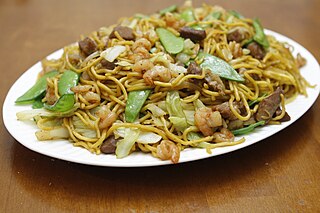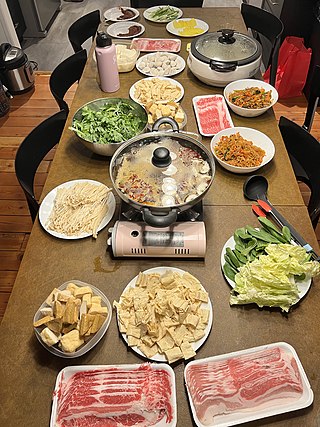
Korean cuisine has evolved through centuries of social and political change. Originating from ancient agricultural and nomadic traditions in Korea and southern Manchuria, Korean cuisine reflects a complex interaction of the natural environment and different cultural trends.

Bulgogi is a gui made of thin, marinated slices of meat, most commonly beef, grilled on a barbecue or on a stove-top griddle. It is also often stir-fried in a pan in home cooking. Sirloin and rib eye are frequently used cuts of beef for the dish. Bulgogi is a very popular dish in South Korea, where it can be found anywhere from upscale restaurants to local supermarkets as pan-ready kits.

Bibimbap, sometimes romanized as bi bim bap or bi bim bop, is a Korean rice dish.

Korean royal court cuisine was the style of cookery within Korean cuisine traditionally consumed at the court of the Joseon Dynasty, which ruled Korea from 1392 to 1910. There has been a revival of this cookery style in the 21st century. It is said that twelve dishes should be served along with rice and soup, with most dishes served in bangjja (bronzeware).

Pancit, also spelled pansít, is a general term referring to various traditional noodle dishes in Filipino cuisine. There are numerous types of pancit, often named based on the noodles used, method of cooking, place of origin or the ingredients. Most pancit dishes are characteristically served with calamansi, which adds a citrusy flavor profile.

Noodle soup refers to a variety of soups with noodles and other ingredients served in a light broth. Noodle soup is a common dish across East Asia, Southeast Asia and the Himalayan states of South Asia. Various types of noodles are used, such as rice noodles, wheat noodles and egg noodles.

Soups in East Asian culture are eaten as one of the many main dishes in a meal or in some cases served straight with little adornment, particular attention is paid to the soups' stocks. In the case of some soups, the stock ingredients become part of the soup. They are usually based solely on broths and lacking in dairy products such as milk or cream. If thickened, the thickening usually consists of refined starches from corn or sweet potatoes.

Soybean sprout is a culinary vegetable grown by sprouting soybeans. It can be grown by placing and watering the sprouted soybeans in the shade until the roots grow long. Soybean sprouts are extensively cultivated and consumed in Asian countries.

Banchan are small side dishes served along with cooked rice in Korean cuisine. Banchan are often set in the middle of the table to be shared. At the center of the table is the secondary main course, such as galbi or bulgogi, and a shared pot of jjigae. Bowls of cooked rice and guk (soup) are set individually. Banchan are served in small portions, meant to be finished at each meal and replenished during the meal if not enough. Usually, the more formal the meals are, the more banchan there will be. Jeolla province is particularly famous for serving many different varieties of banchan in a single meal.

Haejang-guk or hangover soup refers to every kind of guk or soup eaten as a hangover cure in Korean cuisine. It means "soup to chase a hangover" and is also called sulguk (술국). It usually consists of dried napa cabbage, vegetables and meat in a hearty beef broth. One type of haejangguk, seonjiguk, includes sliced congealed ox blood and another type, sundaeguk, includes a kind of blood sausage made with intestine stuffed with pig's blood and other ingredients.

Korean noodles are noodles or noodle dishes in Korean cuisine, and are collectively referred to as guksu in native Korean or myeon in hanja character. Preparations with noodles are relatively simple and dates back to around 6000 BCE to 5000 BCE in Asia. In Korea, traditional noodle dishes are onmyeon, called guksu jangguk, naengmyeon, bibim guksu, kalguksu, kongguksu among others. In royal court, baekmyeon consisting of buckwheat noodles and pheasant broth, was regarded as the top quality noodle dish. Naengmyeon, with a cold soup mixed with dongchimi and beef brisk broth, was eaten in court during summer.

Javanese cuisine is the cuisine of Javanese people, a major ethnic group in Indonesia, more precisely the province of Central Java, Yogyakarta and East Java.

Pyeonyuk is a traditional Korean dish, which consists of thinly sliced meat that has been boiled and pressed. Either beef or pork may be used to make the dish.

Doenjang-jjigae (Korean: 된장찌개), referred to in English as soybean paste stew, is a Korean traditional jjigae, made from the primary ingredient of doenjang, and additional optional ingredients vegetables, seafood, and meat. It is one of the most iconic and popular traditional dishes in Korean cuisine, and is often eaten regularly regardless of occasion or time of day. Doenjang-jjigae was initially made with home-made doenjang; however, due to extensive industrialisation of soybean paste, households and restaurants nowadays use factory-made doenjang instead as their ingredient. From traditional to modern Korean cuisine, doenjang has become one of the most frequently used jang (sauce/paste). It is claimed as a national dish.

Gukbap is a Korean dish made by putting cooked rice into hot soup or boiling rice in soup. It is commonly served in a ttukbaegi. Whereas soup and rice is generally eaten separately in Korea, in gukbap, rice is expected to be mixed into the soup.
Korean regional cuisines are characterized by local specialties and distinctive styles within Korean cuisine. The divisions reflected historical boundaries of the provinces where these food and culinary traditions were preserved until modern times.

Kongnamul-bulgogi, sometimes abbreviated as kongbul (콩불), is a modern Korean dish. It is a combination of bulgogi, bean sprouts, rice cake, vegetables, noodles, sausages, and spicy sauce. The ingredients are roasted in a large pan. The dish has become increasingly popular in South Korea, especially among teenagers, due to its low price and appealing flavour.

Hot pot or hotpot, also known as steamboat, is a dish whereby a heat source placed on the dining table keeps a pot of soup stock simmering, and accompanied with an array of Chinese foodstuffs and ingredients and food offerings provided for the diners to dip into the flavorful broth.

Indonesian noodles are a significant aspect of Indonesian cuisine which is itself very diverse. Indonesian cuisine recognizes many types of noodles, with each region of the country often developing its own distinct recipes.














































